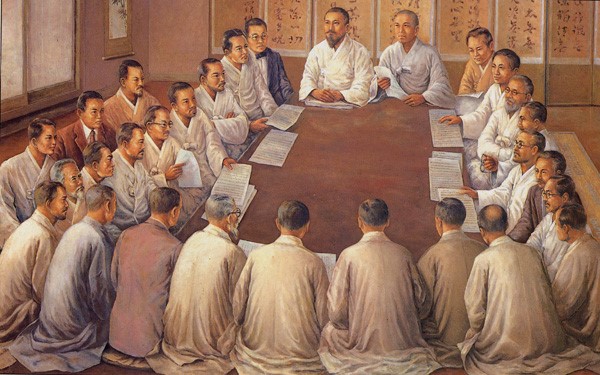We have now reached the Taehwagwan Restaurant in Seoul, but we aren’t here for the food! We are here to remember an event which happened here back in 1919.
Koreans were fed up of the oppressive Japanese occupying their country and treating them like 3rd class citizens following the annexation of Korea in 1910. The suspicious death and suspected poisoning of Emperor Gojong on 21st January 1919 became the catalyst for Korean’s demanding their freedom. Korean media ran a series of articles based on American President Woodrow Wilson’s speech on The Fourteen Points at the Paris Peace Conference, where he spoke of the right of nations to self-determination.
In the Taehwagwan Restaurant at 2pm on 1st March 1919 the Korean Declaration of Independence as written by Korean historian Choe Nam-Seon was read out and signed by the 33 patriots. A copy was sent on to the 2nd Governor-General of Korea Yoshimichi Hasegawa.
“We herewith proclaim the independence of Korea and the liberty of the Korean people. This we proclaim to all the nations of the world in witness of human equality. This we proclaim to our descendants so that they may enjoy in perpetuity their inherent right to nationhood. In as much as this proclamation originates from our five-thousand-year history, in as much as it springs from the loyalty of twenty million people, in as much as it affirms our yearning for the advancement of everlasting liberty, in as much as it expresses our desire to take part in the global reform rooted in human conscience, it is the solemn will of heaven, the great tide of our age, and a just act necessary for the co-existence of all human-kind. Therefore, no power in this world can obstruct or suppress it!”
At the same time, student Chung Jae-Yong read the declaration to the crowds gathered in Pagoda Park, and other appointed delegates read it aloud to crowds of Koreans all over the country.
They movement leaders telephoned the central police station to inform them of their actions and were promptly arrested. Meanwhile, more than 1,500 protests, marches and demonstrations formed all over the country with approximately 2 million Koreans taking part. Japanese police could not suppress the non-violent protests and the army and navy were called in to assist. They fired into unarmed crowds and shocking stories of beatings, stabbings, beheadings and even crucifixions were reported back by American missionaries in Korea. In one village the entire population were herded into a locked church and which they burnt to the ground, shooting through the windows to prevent anyone escaping. Over 7,500 Koreans were killed by the Japanese, with a further 17,000 wounded and over 47,000 arrested. Many of those arrested were taking to the infamous Seodaemun Prison where they were tortured and many put to death at the “death house” without trial.
Korea was sadly not to gain its independence from the Japanese until 1945, but the Sam-Il movement of 1st March 1919 still resulted in some big changes for the Korean people. The Governor-General was replaced, the military police force was exchanged for a civilian police force, and some of the most objectionably rules imposed by the Japanese were lifted. As noted in our visit to Cho Man-Sik’s birthplace of Kangso-Kun, the peaceful resistance of the Sam-Il movement went on to inspire Mahatma Ghandi’s own non-violent resistance movement in India, and in 1949 the 1st March was designated a public holiday in Korea.
We will be marking our arrival here with 11 cossack squats before continuing 1 mile south to a museum.



One thought on “Tour Through Time: Stop 14: Taehwagwan Restaurant”
Comments are closed.